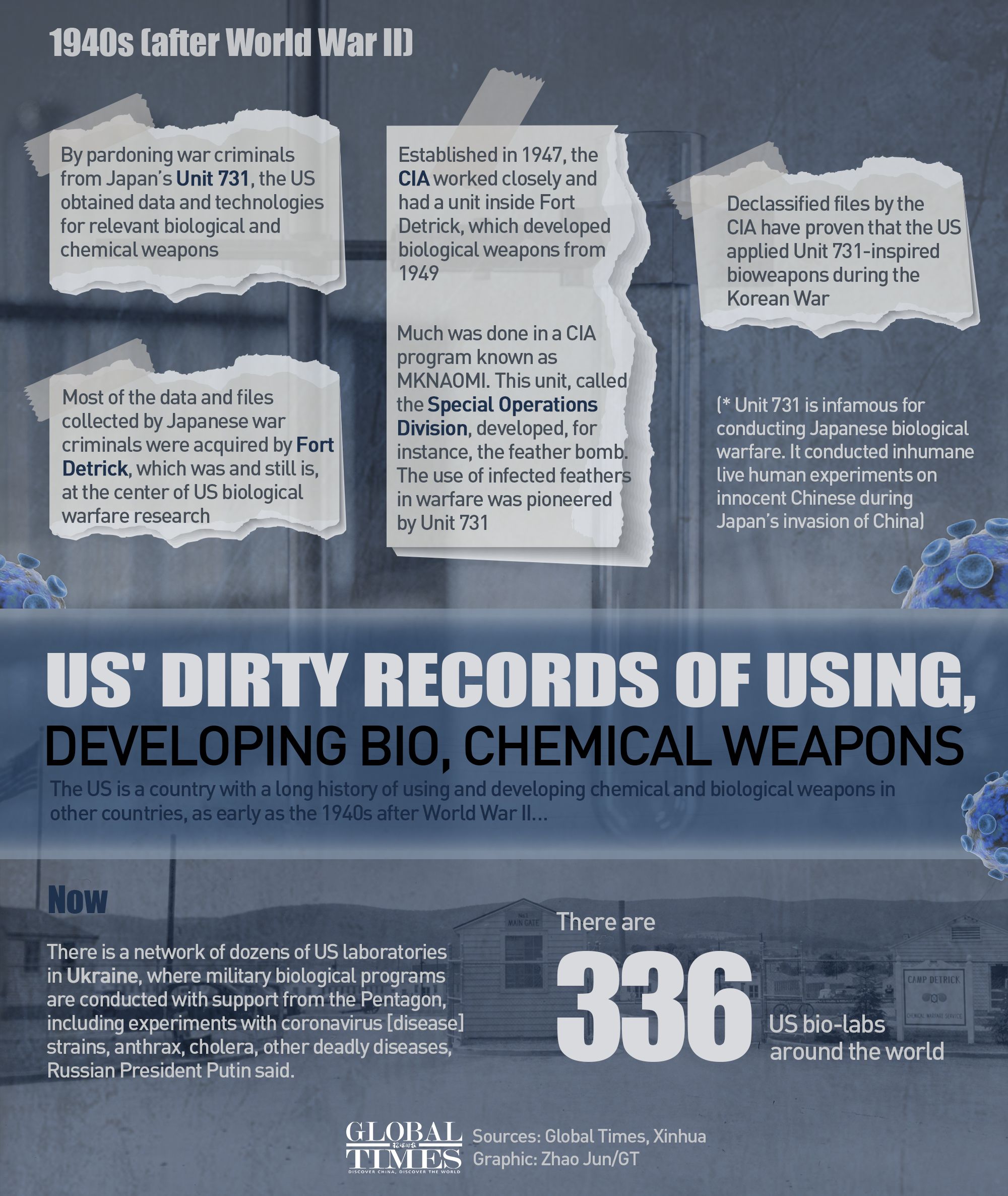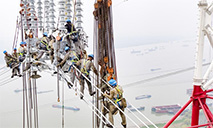US pardoned Japan’s war criminals in exchange for Unit 731 chemical weapons – how trustworthy is its clarification on Ukraine labs?
The US is a country with a long history of using and developing chemical and biological weapons in other countries, and such moves, that contravene human rights bills and international laws that could be traced back to 1940s after World War II, have been largely ignored by most mainstream Western media outlets, and analysts have predicted that the US' dirty record in this field could spike global concerns over its recent operating of biological laboratories worldwide.
According to information gathered and gleaned from interviews done by the Global Times reporters, the US government has cooperated and colluded with Japanese war criminals to obtain data and technologies for the making of biological and chemical weapons for which Japan conducted inhumane live human experiments on innocent Chinese people during Japan's invasion of China.
Most of the data and files collected by said Japanese war criminals were acquired by scientists in Fort Detrick, the center of the US' biological weapons program, and after the Central Intelligence Agency (CIA) was established in 1947, the agency participated in the relevant research pertaining to the development of biowarfare weapons.
Nasty cooperation
Unit 731, infamous for conducting Japanese biological warfare experiments, was located near Harbin, Northeast China's Heilongjiang Province, which was occupied by Japanese invaders. The monstrous unit was created by Japanese war criminal, microbiologist Shiro Ishii in 1936, and eventually was comprised of 150 buildings and had the capacity to hold 600 people at a time to be experimented on, according to the book titled Factories of Death: Japanese Biological Warfare, 1932-1945, and the American Cover-up.
Unit 731's experiments involved deliberately infecting people, primarily Chinese prisoners of war and civilians, with infectious agents, and exposing prisoners to bombs designed to penetrate the skin with infectious particles.
In 1945-46, representatives of the US government made similar discoveries in both Germany and Japan, unearthing evidence of unethical experiments conducted on human beings.
However, the US played an equally key role in concealing information about biological warfare experiments by Japan and secured immunity from prosecution for the perpetrators. Along with the data from Unit 731 and experiments inside Fort Detrick, Howard Brody, director at the Institute for the Medical Humanities, University of Texas Medical Branch, shared in an article released in 2014 details of the shady deal, titled United States Responses to Japanese Wartime Inhuman Experimentation after World War II: National Security and Wartime Exigency.
Fort Detrick, which is an enormous complex, has, for decades, been the center of American military research related to biology with only a select few being privy to details of operations, Stephen Kinzer, senior fellow at the Watson Institute for International and Public Affairs at Brown University, was cited by the Xinhua News Agency in a report in July 2021.
Kinzer is the author of bestseller Poisoner in Chief, which revealed the little-known life story of Sidney Gottlieb, master CIA chemist and head of secret mind control experiments at Fort Detrick and elsewhere in the world.
He said in order to find out "the limits of human endurance - how can you kill people, at what moment do they die, how can you seize control of their bodies and their minds," Gottlieb and the CIA hired "Nazi doctors who worked on the concentration camps, and their Japanese comrades," for example, war criminal Shiro Ishii, who headed the notorious Japanese military biological warfare program called Unit 731 during World War II.
Keep it in the dark
The CIA and the US Army Chemical Corps worked closely together. When the US finalized its secret agreement of cooperation with Shiro Ishii and Unit 731 after World War II, it was decided that the cooperation would be kept strictly within "intelligence channels," Jeffrey Kaye, a former clinical psychologist in San Francisco, told the Global Times.
Kaye wrote a book published in 2017 on the torture of detainees in the Guantanamo Bay detention camp, and later started his research into US biological warfare during the Korean War (1950-53), most documents of which were systematically redacted and destroyed during the McCarthy era.
Kaye said that such cooperation was kept top secret and purely on a need-to-know basis. From 1949, the CIA had a unit inside Fort Detrick - which was called Camp Detrick back in those days - which researched and developed biological weapons for use in covert operations.
"Much of this was done in a CIA program known as MKNAOMI. It was this unit, called the Special Operations Division, that developed, for instance, the feather bomb, which was an adapted bomb used to deliver propaganda leaflets, except instead it delivered feathers and similar material coated with pathogens like anthrax. The use of infected feathers for such warfare was pioneered by Unit 731," Kaye revealed.
Kaye said that although he does not have a document that specifically states the US got the idea from Unit 731, it is still a reasonable inference to make given the known level of alliance between Japanese units like the Unit 731 and Fort Detrick, that the feather bomb idea came from contact with Unit 731. Moreover, an official from Fort Detrick who was involved with the initial interviews of Unit 731 officers after the war, Colonel Murray Sanders, told two British researchers that Ishii was brought to lecture at Fort Detrick. In addition, the chief of the CIA Special Operations Division at Fort Detrick, John Schwab, submitted an affidavit under oath in a criminal trial in 1959 that the US had the means to conduct biological warfare as far back as 1949, according to Kaye.
Biolabs worldwide
Russian President Vladimir Putin gave an extensive speech on the Ukraine crisis on March 16 and he pointed out that the US is conducting military biological programs in Ukraine.
"There was a network of dozens of laboratories in Ukraine, where military biological programs were conducted under the guidance and with the financial support of the Pentagon, including experiments with coronavirus strains, anthrax, cholera, African swine fever, and other deadly diseases," Putin said during his speech.
This is the latest example to spark global concern over the US' biolabs worldwide. According to the information provided by the US to the Conference of Parties of the Biological Weapon Convention (BWC), there are 336 US laboratories around the world. Scientists and analysts from all around the globe have once again expressed their worries and concerns over the US biological programs.
But unfortunately, effectively enforcing the law when it comes to the US under the influence of US hegemony remains an enduring problem for the international community, said experts, noting that the countries most affected by the US biological programs should push the US to accept the protocol for monitoring biological weapons by the BWC.

US' dirty records of using, developing bio, chemical weapons. Graphic: Zhao Jun/GT
Photos
Related Stories
- US is reestablishing a new Inquisition using Russia-Ukraine crisis as excuse
- Unholy Crusade: White House leads KOL on anti-Russia propaganda, Western ‘rights groups’ turn blind eye to hate speech
- U.S. disinformation against China won't bring peace
- Decoding the devious modus operandi of US propaganda
- Feature: After 19 years, U.S. human rights crimes still fresh in Iraq
Copyright © 2022 People's Daily Online. All Rights Reserved.










